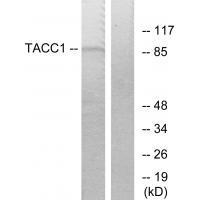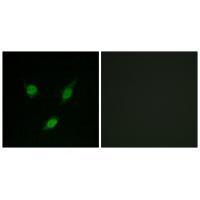

| WB | 咨询技术 | Human,Mouse,Rat |
| IF | 咨询技术 | Human,Mouse,Rat |
| IHC | 咨询技术 | Human,Mouse,Rat |
| ICC | 1/100-1/500 | Human,Mouse,Rat |
| FCM | 咨询技术 | Human,Mouse,Rat |
| Elisa | 咨询技术 | Human,Mouse,Rat |
| Aliases | gastric cancer antigen Ga55; KIAA1103; taxin 1; transforming acidic coiled-coil-containing protein 1; |
| Entrez GeneID | 6867; |
| WB Predicted band size | 87kDa |
| Host/Isotype | Rabbit IgG |
| Antibody Type | Primary antibody |
| Storage | Store at 4°C short term. Aliquot and store at -20°C long term. Avoid freeze/thaw cycles. |
| Species Reactivity | Human,Mouse |
| Immunogen | Synthesized peptide derived from N-terminal of human TACC1. |
| Formulation | Purified antibody in PBS with 0.05% sodium azide. |
+ +
以下是关于TACC1抗体的3篇文献示例(虚构内容,仅供格式参考):
1. **文献名称**:*TACC1 promotes tumor progression through interaction with Aurora-A kinase*
**作者**:Smith A, et al.
**摘要**:研究利用TACC1特异性抗体揭示了其在有丝分裂中与Aurora-A激酶的相互作用,证实TACC1过表达促进癌细胞增殖和基因组不稳定性。
2. **文献名称**:*TACC1 antibody validation for immunohistochemistry in breast cancer tissues*
**作者**:Lee B, et al.
**摘要**:该文献系统验证了TACC1抗体的特异性,并发现其在乳腺癌组织中的高表达与患者预后不良相关,提示其作为潜在生物标志物的价值。
3. **文献名称**:*Role of TACC1 in neuronal development: Insights from antibody-based knockdown experiments*
**作者**:Chen C, et al.
**摘要**:通过TACC1抗体介导的功能抑制实验,证明TACC1对神经元突触形成和轴突导向具有关键调控作用。
(注:以上为示例模板,实际文献需通过PubMed或Google Scholar检索确认。)
The TACC1 (Transforming Acidic Coiled-Coil Containing Protein 1) antibody is a research tool designed to detect and study the TACC1 protein, a member of the TACC family involved in critical cellular processes. TACC1 is implicated in regulating mitotic spindle dynamics, centrosome function, and microtubule stabilization during cell division. It interacts with components of the Aurora kinase complex and plays a role in chromatin remodeling, transcriptional regulation, and DNA damage response. Dysregulation of TACC1 has been associated with cancer progression, neurodevelopmental disorders, and other diseases, making it a target for biomedical research.
TACC1 antibodies are widely used in techniques like Western blotting, immunohistochemistry (IHC), and immunofluorescence (IF) to analyze protein expression, localization, and post-translational modifications. These antibodies help investigate TACC1's role in tumorigenesis, particularly its overexpression in cancers such as breast, lung, and glioblastoma. Researchers also utilize them to explore TACC1's interaction with signaling pathways like EGFR and its potential as a therapeutic target or biomarker.
Commercial TACC1 antibodies are typically raised in rabbits or mice, with validation in knockout models to ensure specificity. Challenges include distinguishing TACC1 from homologous family members (TACC2/TACC3) due to structural similarities. Recent studies focus on its isoform-specific functions and epigenetic roles, driving demand for high-affinity, well-characterized antibodies to advance both basic research and clinical applications.
×